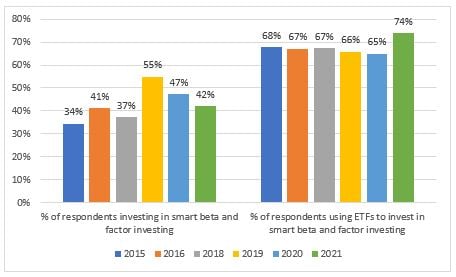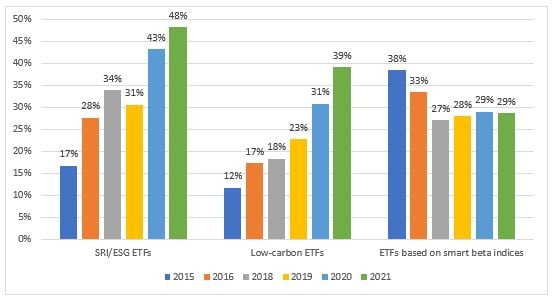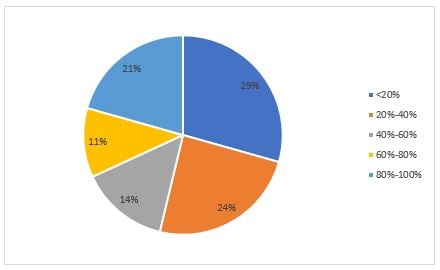
ESG Investing Gains Momentum
by Véronique Le Sourd, Senior Research Engineer, EDHEC-Risk Climate Impact Institute and Lionel Martellini, Former Director, EDHEC-Risk Institute
Almost every year since 2006, EDHEC has conducted a survey on European professional investors’ views and uses of ETFs, as part of the Amundi research chair at EDHEC-Risk Institute on “ETF, Indexing and Smart Beta Investment Strategies”. Our survey also investigates investor use of smart beta and factor investing strategies and focuses on investor interest in SRI (Socially Responsible Investing)/ESG (Environmental, Social, Governance) investing, both in the context of ETFs and smart beta and factor investing strategies.
The EDHEC European ETF, Smart Beta and Factor Investing Survey 2021 was conducted between mid-February and the beginning of April 2021, using an online questionnaire addressed to European professionals in the asset management industry. It targeted institutional investors, as well as asset management firms and private wealth managers. Our 202 respondents, of whom 81% use ETFs, were high-ranking professionals within their organisations (39% belong to executive management and 31% are portfolio managers), with large assets under management (37% of respondents represent firms with AuM exceeding €10bn). Respondents were distributed across different European countries, with 67% from European Union member states, 15% from Switzerland, 13% from the United Kingdom and 5% from other countries outside the European Union.
The notable results of this year’s survey were a slowdown in the use of smart beta and factor investing strategies, and a growing interest in the integration of an SRI/ESG component into investment.
Here we provide a summary of the survey results emphasising the key conclusions.
HOW INVESTORS USE ETFS AND THEIR EXPECTATIONS FOR FUTURE DEVELOPMENTS
Over the years, our surveys have revealed a broad uptake of ETFs to invest in the main asset classes, with 93% of respondents using ETFs to invest in equities in 2021, 68% using them to invest in corporate bonds, and 67% to invest in government bonds. Such levels have been observed for more than a decade. For other investments, such as SRI/ESG and smart beta and factor investing, the use of ETFs has developed more recently. These two asset classes deserve a special focus in the analysis of the survey results, as we found that the former is expanding while the latter is stagnating or even losing popularity among European investors.
SRI/ESG ETFs
In 2015, only 19% of respondents were investing in SRI/ESG, compared to 55% of respondents in 2021, of whom 67% have used ETFs to invest in SRI/ESG in 2021, whereas these figures were only 12% in 2015 and 33% in 2019 (see Exhibit 1). From Exhibit 1, we see that consideration of SRI/ESG within investment has mainly risen since 2019 and that the use of ETFs particularly began to develop in 2020. Aggregating the results, we find that 37% of all ETF users were using ETFs based on SRI/ESG in 2021, compared to only 2% in 2015. In terms of AuM, 27% of investment in SRI/ESG was made through ETFs in 2021, versus 39% in 2020. This decrease in intensity may be explained by the arrival of new users whose share invested in SRI/ESG may be lower than that of investors present in this market segment for longer.
Exhibit 1: SRI/ESG ETF Usage

Smart beta and factor investing ETFs
If we look at the proportion of respondents investing in this asset class, we see a decline since 2020. In 2021, 42% of respondents were investing in smart beta and factor investing strategies, compared to 47% in 2020 and 55% in 2019, the highest level over the period (see Exhibit 2). However, ETFs remain an appealing instrument for this asset class. 74% of respondents were using ETFs to invest in smart beta and factor investing in 2021, versus 65% in 2020. In terms of AuM, 33% of investment in smart beta and factor investing was made through ETFs in 2021, versus 47% in 2020.
Exhibit 2: Smart Beta and Factor Investing ETF Usage

The Role of ETFs in the Asset Allocation Process
Our survey results clearly indicate that the current usage of ETFs is dominated by a truly passive investment approach. Despite the possibilities that ETFs offer for implementing tactical changes, due to their liquidity and low costs, they are mainly used for long-term exposure. Some 66% of respondents use ETFs for buy-and-hold investments, while only 37% use them for tactical bets. Moreover, achieving broad market exposure remains the main focus of ETFs for 74% of users, compared with 53% of respondents using ETFs to obtain specific sub-segment exposure.
Cost and quality of replication are the two main drivers for selecting ETF providers (90% and 84% of respondents, respectively), related to the main motivations for using ETFs, namely reducing investment costs while tracking index performance. Qualitative criteria considered by investors are breadth of the range and the provider’s long-term commitment (42% and 41% of respondents, respectively).
Future Development of ETFs
In 2021, 49% of investors planned to further increase their use of ETFs in the future, despite the already high maturity of this market and high adoption rates. Lowering investment costs is the primary driver behind investors’ future adoption of ETFs (85% of respondents). In addition, investors are not only planning to increase their ETF allocation to replace active managers (65% of respondents) but are also seeking to replace other passive investing products through ETFs (46% of respondents).
The top priority for 48% of respondents is currently the further development of SRI/ESG ETFs. In second position, 39% of respondents called for more development of low-carbon ETFs. Additionally, for ETFs related to smart beta indices, 29% of respondents called for further developments (see Exhibit 3). The demand for ETFs based on single-factor or multi-factor indices is far behind (20% and 18%, respectively).
Exhibit 3: Type of ETF Products to be Further Developed in the Future

If we aggregate the responses concerning SRI/ESG and low-carbon ETFs, we see that 60% of respondents would like to see further developments in at least one of the two categories, compared with 50% in 2020 and 38% in 2019. In the same way, if we aggregate the responses concerning smart beta indices with demand for ETFs based on single-factor and multi-factor indices, we find that 45% of respondents would like to see further developments in at least one category related to smart beta equity or factor indices, compared with 43% in 2020 and 45% in 2019. It is interesting to note that since 2020, the demand for further development of ETFs based on SRI/ESG and low-carbon indices took the lead ahead of the demand for further development of smart beta and factor indices ETFs.
PRESENT AND FUTURE INVESTOR APPROACHES TO ESG
In view of the significant development of ESG integration in ETFs, it was interesting to further investigate investors’ positions with regard to ESG. First, we note that the proportion of respondents investing in SRI/ESG is a little higher among the 81% of respondents that use ETFs than in overall sample (55% versus 51%). Among those that do not yet include ESG considerations in their investment, 68% are considering incorporating ESG into their portfolio in the near future.
Respondents are implementing ESG mainly in the equity (82%) and fixed-income (57%) asset classes. 21% also consider ESG in the real estate asset class and 15% in other asset classes, including private equity (5%) and infrastructure (4%).
Their preferred approach to ESG is the best-in-class (i.e. positive screening) approach, far ahead of the other two, with 44% of respondents preferring it over the thematic approach (34%) and the negative screening approach (22%) (see Exhibit 4).
Exhibit 4: Preferred Approach to ESG

The two main reasons respondents find it important to incorporate ESG into investment decisions were to facilitate a positive impact on society (64%) and to reduce long-term risk (61%). Interestingly, only one-third (34%) think that incorporating ESG will serve to enhance portfolio performance. However, when respondents were asked if they were willing to accept lower performance in exchange for a better ESG score, almost two-thirds (65%) said they were not. It will therefore be important to find the right balance between the ESG score and portfolio performance.
Respondents were also asked about the approach they consider best in reducing a portfolio’s carbon footprint to move towards alignment with the Paris agreement benchmarks, i.e. to limit global temperature increases to 1.5°C. 48% consider the best approach to be positive screening. Portfolio optimisation comes in second position (31% of respondents). Lastly, only 21% of respondents consider negative screening to be the best approach.
44% of respondents consider ESG as a factor, while 46% do not, and 10% have no opinion. Respondents said they observe factor biases when incorporating ESG into their portfolio, mainly sector bias (46% of respondents) and quality bias (41%). As a result, 61% think that sector or neutrality constraints are appropriate when using an ESG filter.
Respondents indicate they intend to use ETFs to incorporate ESG into their portfolio, first to improve its overall sustainability (cited by 48%), and second to incorporate ESG across their passive allocation (45%). Incorporating innovative ESG exposures came in last position, cited by 30% of respondents.
71% of respondents include ESG considerations in more than 20% of their assets and 21% of them do so in more than 80% of their assets (see Exhibit 5), which shows the significant place that ESG holds in investment for those who already consider it.
Exhibit 5: Percentage of Overall Assets Incorporating ESG
In addition, 80% of respondents plan to increase their portfolio exposure to ESG in the near future. It should be noted that two respondents declared that their portfolio was already almost entirely invested according to ESG criteria and that they therefore did not foresee an increase of their ESG exposure.
62% of respondents indicate that the main reason that prevents them from developing their use of ESG is the lack of standards and consistency in ESG products, while 39% mention a lack of transparency in ESG products. Only 15% of respondents do not see investing in ESG as a priority. Not surprisingly, 78% of respondents believe that improvements in ESG regulation across Europe will enable them to make better ESG allocations.
KEY OBJECTIVES DRIVING THE USE OF SMART BETA AND FACTOR INVESTING STRATEGIES
Survey participants were also invited to give their opinion on smart beta and factor investing strategies beyond their use through ETFs.
Use of Smart Beta and Factor Investing Strategies
The main motivation behind the adoption of smart beta and factor investing strategies is to improve performance. Managing risk is also considered an important criterion. 37% of participants currently invest in smart beta and factor investing strategies; 23% do not but are considering adopting such strategies in the future. We note that the proportion of respondents investing in smart beta and factor investing strategies is a little higher among respondents who use ETFs (42%), as displayed in Exhibit 2, than in the overall sample of respondents (37%). 2020 saw a significant decrease in the share of respondents that use smart beta and factor investing solutions: while only about one-fifth of investors were not investing or considering investment in such products in the near future in 2019, they now represent two-fifths, as in 2020.
Smart beta and factor investing investments also typically make up only a small fraction of portfolio holdings among those respondents who have made investments in these strategies. Almost three-quarters of respondents (73%) allocate less than 20% of their total investments in smart beta and factor investing strategies, and only 10% of respondents invest more than 40%. However, 37% of respondents are planning an increase of more than 10% in terms of assets in their use of smart beta and factor investing products in the near future, while only 10% indicate a planned decrease.
Implementation of Smart Beta and Factor Investing Strategies
Our survey generates several insights into how investors implement their smart beta and factor investing strategies. Slightly more respondents are using discretionary smart beta and factor investing strategies (61%), rather than replicating strategies (57%). In terms of the actual product wrapper used for smart beta and factor investing exposure, respondents currently favour passive funds that replicate smart beta and factor investing indices (64% of respondents), ahead of active solutions, i.e. approaches including a significant amount of discretion (47% of respondents). Respondents most frequently use smart beta/factor-based exposures to harvest long-term premia (as opposed to tactical use).
The existence of factor risk premium, ease of implementation and academic evidence are the primary concerns when it comes to smart beta and factor investing strategy factors.
Smart Beta and Factor Investing Strategies in Fixed Income
The results of our survey show that 15% of the overall sample of respondents currently use smart beta and factor investing for fixed income. However, about two-thirds (67%) of this sub-sample do so with less than 20% of their total investment. The remaining 85% of respondents say they do not invest in smart beta and factor investing products for fixed income mainly because the offer does not correspond to their needs in terms of risk factor (35%), because risk premia are not sufficiently documented in the literature (26%), and because there is a lack of efficient bond benchmarks (24%).
All respondents, including those who already invest in smart beta and factor investing for fixed income, and those who do not yet invest, show significant interest. However, they are mitigated in their plans to increase their investment in smart beta and factor investing for fixed income in the future, because they have doubts about the maturity of research results for fixed-income strategies.
52% of respondents indicate that smart beta and factor investing bond solutions are useful in performance-seeking portfolios for harvesting risk premia. 46% think that the best solution to achieve efficient harvesting is to use factor investing, i.e. selecting bonds according to rewarded attributes (value, momentum, credit, liquidity). 58%, 54% and 49% of respondents respectively believe that the three typical factors of the credit risk market, namely slope of the yield curve, carry/level of the yield curve and credit, are the most relevant rewarded factors in fixed-income markets.
Future Development of Smart Beta and Factor Investing Strategies
ESG, fixed income and solutions addressing specific investor objectives and alternative asset classes are the main expectations for future development of smart beta and factor investing products (see Exhibit 6).
Exhibit 6: Type of Solutions Requiring Further Developments in the Future (on a scale from 0 – not required – to 5 – strong priority)

CONCLUSION
The 2021 survey shows significant interest in SRI/ESG among respondents, who overwhelmingly answered all questions related to it. Many of them already include this component in their investment, and a large proportion of those who do not yet, plan to do so in the near future. While their main motivation to incorporate ESG criteria into their investment is to facilitate a positive impact on society, the majority of them do not want this to be done at the expense of performance. We note that the proportion of respondents investing in SRI/ESG is a little higher among respondents who use ETFs than among those who do not. The same result is observed for investment in smart beta and factor investing strategies. While ETFs are widely used to invest in popular asset classes, such as equities and fixed income, we can see that they also facilitate the integration of SRI/ESG and investment in smart beta and factor investing strategies.
The research from which this article was drawn was produced as part of the Amundi ETF, Indexing and Smart Beta Investment Strategies research chair at EDHEC-Risk Institute.


